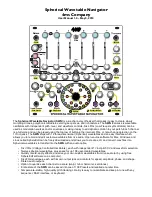
PIPE
USER MANUAL
5
Additional FX touch sensor.
Additional FX are different for each algorithm. They are
described in the section about algorithms. I chose a touch sensor instead of a button because
the sensors have practically unlimited service life, high reliability and high usability. Even
when you press them 10 times/second (which can really happen when you want to quickly
gate the sound or add FX) you can be sure that you will not have to change the buttons
after a few performances.
6
H artist body grounding.
They are needed to hold the PIPE comfortably with
your fingers and not let it slip from your hands. They also serve as second contact point for
the touch sensors. The sensors activate when you complete the circuit between the sensor
and the handle or any other conducting element connected with the ground of the PIPE or
the setup as a whole.
Instead of your body, you can use a wire or any conductor with the resistance of no less
than 10 mOhm (can be useful for various experiments). Artist body grounding can also be
useful to decrease hum and interference.
On the picture below you see the correct way to hold your PIPE if you play with one hand.
The PIPE is made to be held with your left hand.
If the PIPE is the only instrument you are playing at the moment, you can use both hands
to operate it more comfortably: hold the device with your left hand while turning the knobs
and sensors with your right hand. This makes the hand placement more relaxed and playing
the instrument easier.
7
Custom XLR connector for connecting PIPE to the breakout box.
The device is
connected using a special cable that transmits power and L/R audio channels. Please note:
The pin arrangement in the cable and connectors is custom-made for the PIPE. Use only
the cable that is supplied with the PIPE and do not use it with other equipment.
8
Input for microphone or external signal.
6.3 mm TRS jack input. The sleeve is the
ground, the ring is the microphone touch sensor and the tip is microphone/external signal
input. The original microphone jack has a disconnected ring contact. The microphone is
activated using the touch sensor on the PIPE. When a TS (mono) jack cable is used, the
ring (and consequently the activation sensor) will be continually connected to the ground
and the PIPE input will always be on, unaffected by the microphone activation sensor. This
is useful when using the PIPE with external audio signals. Simply use a TS jack cable and
the PIPE input will always be active. It is also useful if you want to place the microphone
on a stand or use it with an acoustic instrument and have both hands free. Use a female/
male TS extension cord to connect the microphone, and the ring of the input connector will
be connected to the ground in the same manner, making the PIPE input always open. It is
possible to create a remote control unit using a TRS extension cable.
Summary of Contents for PIPE
Page 1: ...USER MANUAL ...






































